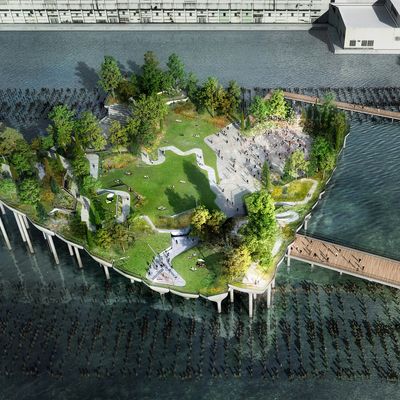
Trying to make New York a fairer place is like raking gravel by hand while dump trucks keep adding to the pile. Last month, Mayor de Blasio announced that he was rejecting his predecessorÔÇÖs penchant for splashy new parks, and instead spreading $130 million around 35 neglected patches of greenery all over the city. Now de Blasio finds himself cheering on another digital media billionaire, Barry Diller, as he pledges exactly the same amount to build a spectacularly Bloombergian new park-on-a-pier. The new landscape and performance space would be a five-minute walk from DillerÔÇÖs office and ten from the headquarters of his wife, Diane von Furstenberg. The couple are sure doing their part to spiff up their neighborhood.
ItÔÇÖs a great deal for New YorkÔÇÖs politicians: $17 million of city funds and another $18 million in state money leverage a great dollop of philanthropic cash, producing (if all goes smoothly, and hey, when does it ever not?) some ravishing offshore topography terraformed by the British designer Thomas Heatherwick. The city has always depended on the kindness of plutocrats ÔÇö we wouldnÔÇÖt have gotten Central Park without them ÔÇö and DillerÔÇÖs proposal would add something genuinely public, astonishing, and useful to the public realm. Why would any public official ÔÇö or any citizen ÔÇö be against it?
But the plan also dramatizes how difficult it is to create a city where such urban bonbons arenÔÇÖt all clustered in one zip code. In exchange for his support, de Blasio might have persuaded Diller to tithe some of his largesse to less glamorous, but already extant, parks. He appears to have missed that opportunity, and now the mayor can only sit back and applaud while a private citizen sets the agenda.
ItÔÇÖs hardly a done deal. Though the renderings are so luscious you can practically smell the fresh grass, this is still New York, which means the debate will be heated, tortured, technical, and long. Some questions come up immediately. Does de Blasio have an ironclad commitment from Diller to keep digging into his kitty when the budget balloons, as it must? Does his generosity adequately provide for maintenance in perpetuity? The environmental impact, the engineering challenges, the secretive design process, the skimpy planning ÔÇö all these and many more questions make the fait far from accompli. In fact, the planÔÇÖs success could depend on how much muscle de Blasio puts behind it. If heÔÇÖs just holding his nose and letting the wealthy have their play space, it will fail. But a new green pier in Chelsea would be a quintessentially New York partnership of capital and government, inequitable but beneficial. All de Blasio has to do to make it happen is channel his inner Bloomberg.



